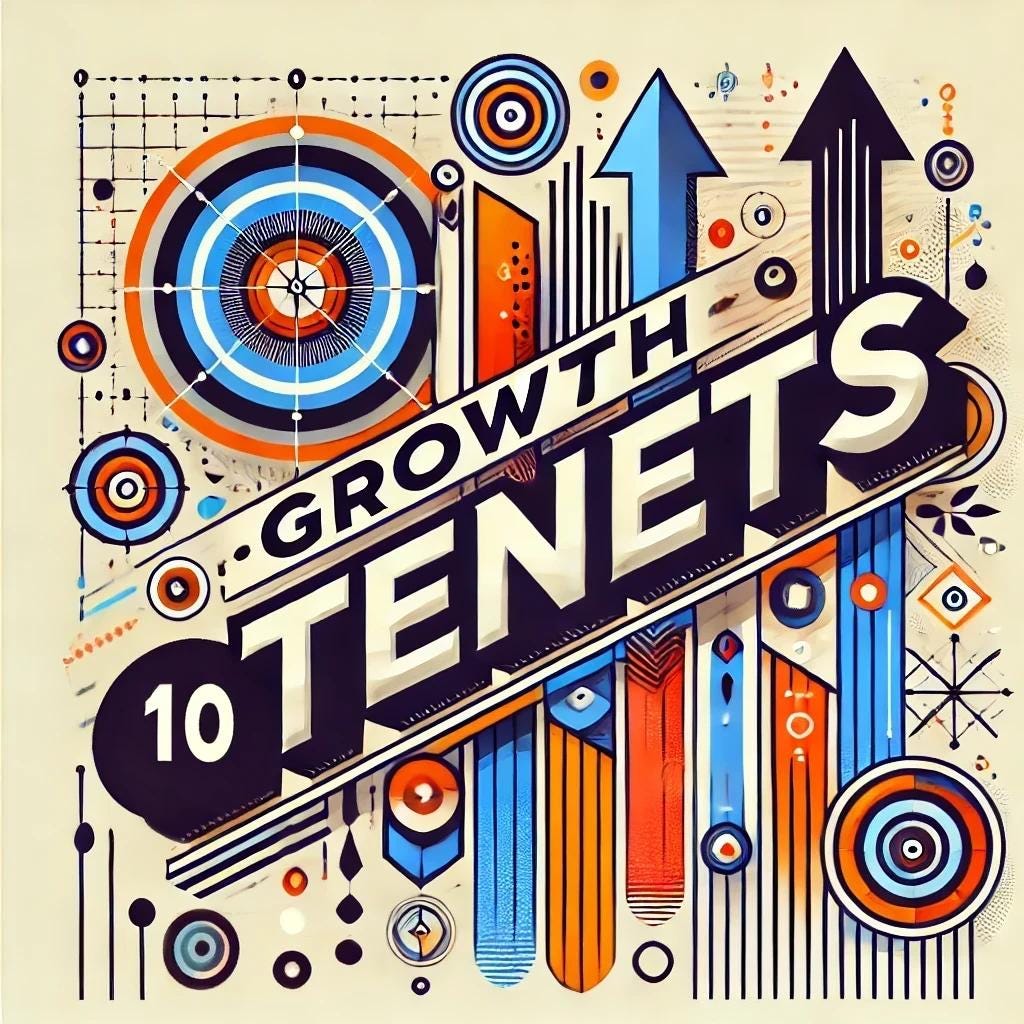The Growlar System Part 2: The TENets
This is a multi-part series outlining my start up and scale growth philosophy. Part 2 is the TENets of my philosophy. There's ten of them. It's clever.
I like to call how I think about startup and scaleup growth the Growlar System. Because I like puns. So get ready for the Growlar System core TENets. Guess how many there are. Note: these aren’t tactics, they are really more of a belief system. If you missed Part 1, it’s here.
Set simple targets
I recognize there are a million books or opinions on setting up OKRs or scaling frameworks or blah blah blah, but time and time and time again I see growth teams and companies twist themselves into knots with their targets.
Ask managers/leaders this one question. If you had to pick ONE number to be accountable to, what would it be and why, and are you on track or not.
Early days? Maybe it’s simply number of demos or number of customers. As you grow, maybe it’s qualified leads, qualified leads to customer conversion, or revenue per customer.
As a hypergrowth company, I personally think there’s actually only one number you need to set, and it’s target rate of growth. That gives the teams everything they need to know. If your rate of growth is X%/month, then every stage of the customer lifecycle needs to grow at X%/month. Simple. If a stage in the journey isn’t growing by X%, then the only answer is that the funnel stage one step before it is to blame. Keep moving your way up until you find the problem. Whispers, “the problem is probably at the top of the funnel. See next TENet.”
Demand Gen Over Everything
Every company in the world should wake up every day and understand that they have a top of funnel problem. Why? Because acquisition is, hands down, the HARDEST thing for a business to do. EVERYTHING else is an optimization problem.
Sam Blond has this as Number 2 on his list of Nine Easy Sales Concepts So Many Get Wrong.
Be Respectfully Impatient
You grow up with an immigrant father, you’re used to being treated with impatience. And as child of immigrants, you’re used to being respectful. Once you grow up, put your hands together.
Growth leaders should never say “let’s see how this goes.” Your goal should be to respectfully pull apart the plans and experiments that your teams propose. Ask questions. Hard ones. You’ll learn a lot about whether folks can deliver based on those questions. Just manage the words you use when you ask those questions. Be respectful.
And also, be impatient. My favorite question to ask is “what specific date are you going to know by?”. If the answer is a quarter, ask what’s stopping it from being a month. If it’s a month, ask why not a week. Why? You need to push to grow, and because almost everything will take longer than planned, growth operators need to consider how to shrink their experiment and project time horizons.
Impatience is often viewed as a negative trait, it’s not.
It Takes a Year
Time and time again in my career, I’ve found that it takes a year to get traction. Product teams often think that the date of release is the date of traction. Generally it isn’t. You won’t start to see any real evidence of market traction for a year.
Now most startup founders, despite their general impatience, recognize this. It’s where their desire for velocity comes from. They understand even the early whiff of PMF can take a year.
As companies scale they begin to lose sight of this. Want a new product in market in Q2 of next year? It should be out in beta in Q2 of this year. You need time to get those first 12 customers, both to get product feedback but to optimize market messaging. And you need way more time than you think for marketing and sales enablement. This is also true for new markets and new GTM motions.
For a long time, I thought I was smart for figuring this out through experience. Then I found the following quotes:
“Getting out of the building and learning from customers takes time—typically a year or more before a company has enough data to pivot, iterate, or scale.” - Steve Blank, The Four Steps to The Epiphany
"A year is a common timeframe to assess whether an innovation has crossed the chasm." - Geoffrey Moore, Crossing the Chasm
"Even with a lean approach, it can take a year or more to truly understand if a product has achieved product-market fit." - Eric Ries, The Lean Startup
“Innovative products require patience as they slowly find their market, a process that can take a year or more." - Clayton Christensen, The Innovator’s Dilemna
“Achieving meaningful traction can take a year or longer, especially in competitive markets.” - Andrew Chen
"Growth takes time. It often takes about a year to find the right strategy and tactics that resonate with your audience." - Sean Ellis
So I guess my point is, it takes a year. And if you don’t believe me, take everyone else’s word for it.
Everything Needs a Business Case
We’ve all heard the saying “do things that don’t scale” when applied to the startup world. However, you should always keep an eye on what it would take to turn that successful “growth hacking” experiment into a scalable driver of growth. A business case helps set scope, goal and time horizon of an experiment. So many growth teams claim to be running “experiments”, but usually they are just trying stuff. An experiment has a hypothesis, success criteria, and a time horizon. Just like a business case.
That’s why, as you grow, everything needs a business case. They don’t have to be extremely complicated. At ZayZoon, ours are three pages and consist of:
Opportunity Summary (What & Why)
Resources (Who & How)
Timelines (What & When)
Outcomes and Analysis (The Numbers)
Evaluation (Self scored and Audience scored)
You can create a business case using this template in hours. Going through this exercise can give you significant insight into upside and milestones, so your “don’t scale” activities can be ring fenced. Most importantly, putting this time in early allows you to move quickly when you have a successful experiment. The business case allows you to answer the question, “If this works, then what?”.
Need a business case template? Let me know, happy to share the one we put together at ZayZoon.
Have Unreasonable Expectations
Look, this site is called the Indian Dad for a reason. Every Indian kid knew the first thing his/her parents would ask when they scored a 95% on an exam would be “what happened to the other 5%”.
Now at work, this is obviously not totally realistic, but expecting great outcomes means making those outcomes clear, and not sugarcoating feedback if outcomes are missed.
Set a high bar, make outcomes clear, drive accountability. Here’s a post from Kieran Flanagan that I think does a fabulous job outlining this.
Get in Person
This applies to working with your own teams and getting into market. I think remote teams can definitely work, but I don’t think there is a replacement for getting cross functional teams and “dot connectors” together in person. So if you’re a remote team, make the time to get together. And if you can swing hybrid, do it.
But in person is even more critical when it comes to partners, clients and prospects. Do site visits for existing clients, do shows for prospects, and go take partners out for lunch. It matters and it works. Why? Here’s one example: A study published in the Harvard Business Review found that face-to-face requests are 34 times more successful than those made over email. While this study is not specific to sales or growth, it highlights the persuasive power of face to face interactions.
And another thing, when you’re in person, BE PRESENT. Getting a booth at a tradeshow? We’ve got a couple of simple rules at ZayZoon. Be at the booth, be the last ones there, get in front of the booth not behind it. You will be amazed at how well this works.
This post from an event we attended is a pretty good reflection of that (even though I ruined it by sitting in a chair).
Retention is a Function of Sales x Product
People are going to read this and think I don’t believe in client success. That’s not the case. What I believe strongly is that the greatest predictor of NRR and low churn are not the people on your success teams, but the genuineness of your sales team and the quality of your product.
Why? Well let’s start with Sales (or marketing in B2C). If sales is good at what they do, sets the right client expectations and tells the TRUTH, then the client is more times than not going to be satisfied during the onboarding and activation processes.
Once the client is beyond initial onboarding, the only thing that matters from that point forward is that the product delivers. That it works, that it drives value, and most importantly, that it’s not a pain in the ass to maintain. That means that when it breaks or is not working, you need to have incredible product support (both self serve and people). But remember, support and success are not the same function.
I’ve read a lot of things that talk about how in B2B, 5x of the revenue occurs post sales and that demonstrates the value of success teams as a growth driver. Some counterpoints:
Companies grow, and that grows ARPU. ZayZoon became a HubSpot customer in March 2020, we spend about 12x on licenses than we did then. We’ve grown from 20 people to 200, and we’ve added modules we never needed before. That’s all product. And we would not have added those modules from HubSpot if we weren’t in the ecosystem already. We got sold, and the product capabilities delivered expansion revenue.
If I buy a product for my business, I am by definition making a long term commitment, regardless of licensing. It is very expensive to forklift something out, or migrate to another solution. Those decisions are difficult to make and costly to execute.
Do I personally appreciate it when a SAAS provider has a capable account manager? Yes. But if my business depends on that platform to run, I care way more about the product and the support teams. Success teams become instrumental on retaining revenue when everything else has gone to shit.
It’s Either Eyeballs or ARPU
You’re either adding eyeballs or you’re increasing ARPU. Early days, optimize for eyeballs. Plenty of time to optimize for ARPU later.
And when it comes to sales or marketing or product experimentation, it’s really critical to push your team on this question. Is the goal to add eyeballs or to add ARPU? This single question helps focus the experiment on the right parts of the funnel, and helps drive experiment velocity.
There’s Only Two Reasons You Don’t Grow
Your product isn’t useful or your people can’t sell/market. If it’s your product, you had better figure it out fast, or you’re dead.
Summary
So the TENets of the Growlar System are:
Set Simple Targets
Demand Gen Over Everything (DGOE)
Be Respectfully Impatient
It Takes a Year
Everything Needs a Business Case
Have Unreasonable Expectations
Get in Person
Retention is a Function of Sales and Product
It’s Either Eyeballs or ARPU
There’s only Two Reasons You Don’t Grow
Do any of these resonate? Do you hate any of these? Let me know in the comments.
And if you missed Part 1…











Love this, especially the point about face-to-face interactions being 34x more effective—those numbers speak for themselves! The emphasis on product quality and genuine sales being the backbone of retention is spot on. It’s so true that client success is important, but nothing beats a product that just works and a sales team that sets clear expectations. And as always, I appreciate how you tie in real-world experiences, like the ZayZoon booth rules—simple but effective. Great insights all around!